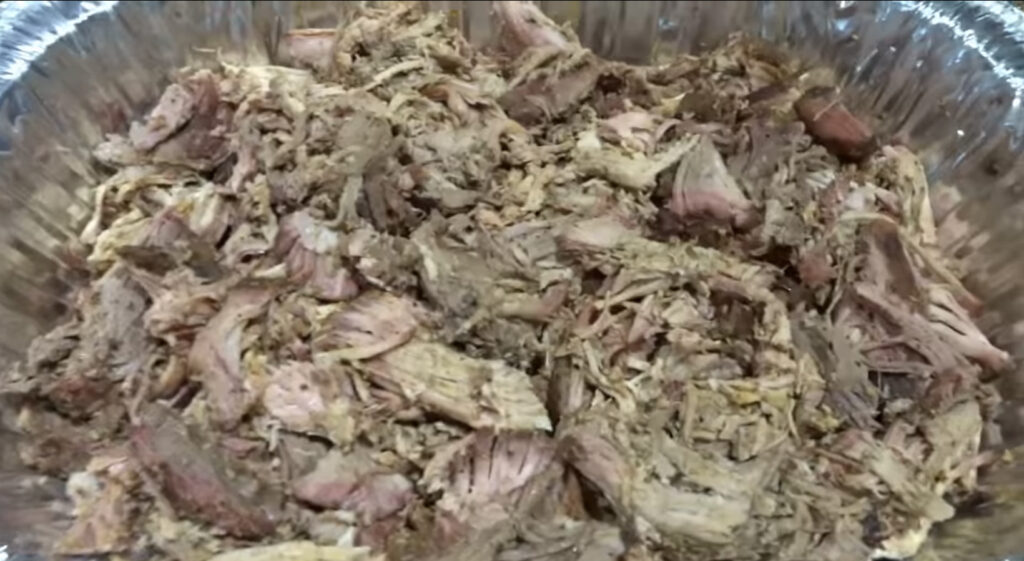If you weren’t already aware, pork is one of the most widely consumed meats in the world and is used in an array of dishes. With the exception of some Jewish and Muslim countries, you’ll find pork is a centerpiece for a lot of countries’ most popular dishes.
Think Bangers and Mash from the UK, or Katsudon from Japan.
Whenever we hear pork we always think of the typical cuts such as bacon, sausage, and the classic pork chop.

However our mission is to expand your horizons, and today we take a look at an underutilized piece of pork and answer the following question: what is pork cushion meat, and how is it prepared?
When it comes to the kitchen, sticking to your comfort zone can be a sensible decision. However there are so many foods out there waiting to be added to your weekly meal plan, and pork cushion meat is well worth the time.
Stick around to find out what pork cushion meat is, how to purchase the right cut, and how to prepare it to perfection.
Pork Cushion Meat – What Is It?
Pork cushion meat is a deboned cut from the large muscle of a pig located on the shoulder joint, also known as the picnic ham, or picnic shoulder. It’s typically cut from the anterior side of the shoulder (at the front), and usually takes a triangular shape.
This particular area of the hogs’ anatomy is known for getting a lot of exercise, which essentially translates to ‘lots of flavor with minimal fat and connective tissue.’ In other words, it’s lean and delicious.
The pork cushion meat has a very mild taste that lends itself well to a variety of dishes. It’s perfect for use in sandwiches, tacos, burgers, and even salads.
But it’s also ideal for meals that take a long time to cook, which we’ll discuss in just a second.
Meals you can find on pork cushion are roasts, stews, basically anything that comes with a thick sauce. Because this particular area needs a little longer cooking due to the toughness of the meat, it is often sold cheaper than fattier cuts of pork.
How To Get Your Hands On Pork Cushion Meat
There are two ways to get your hands on pork cushion meat. You can either go through an online retailer like Amazon, or you can visit a local grocery store.
Either way, you’ll need to know where to look, and what to ask for when purchasing.
You’ll want to make sure that the pork cushion meat you’re buying is USDA-certified organic. This ensures that the pigs were raised without antibiotics and hormones, and they were fed 100% organic feed.
You’ll also want to make sure you buy pork cushion meat that is vacuum-packed. This will ensure that the meat stays fresh, and won’t dry out during transport.
Vacuum packing allows the meat to breathe, keeping it moist and tender. You’ll want to look for a package that contains at least 10 pounds of pork cushion meat.
Another option is to get a whole pork shoulder, but if you’re looking for something that is going to last you a while, then buying pre-packaged pork cushion meat is the way to go.
Once you have purchased your pork cushion meat, you should store it in the refrigerator until you are ready to cook it.
It’s very likely that larger supermarket chains will stock this cut of meat. However, in some rural areas, this can be a lot more difficult to source.
Your best bet is to find a local butcher and say that you intend to make this meal a regular occurrence in your weekly meal preparation. They can then place an order and have some delivered especially for you.
It always helps to be passionate about your request, as they’ll be more than happy to help a customer that is excited about their meals!
How To Cook Pork Cushion Meat
Cooking pork cushion meat is simple enough, but it does require some patience. When cooking pork cushion, you want to keep the heat low and slow.
The reason why is because this type of meat requires a lot of attention to detail. If you don’t pay close attention to the cooking process, you could end up overcooking the meat.
To begin the cooking process, you’ll want to start by seasoning the pork cushion meat with salt and pepper. Next, you’ll want to brown the pork cushion meat in a pan over medium-low heat. While doing so, you’ll want to add some olive oil to the pan.
Once the pork cushion meat starts to brown, you’ll want to transfer it to a slow cooker. Depending on the size of your slow cooker, you may only need one pound of pork cushion meat, so bear this in mind before you begin to cook.
The ideal temperature range to cook pork cushion meat is between 180 °F and 200 °F. If you don’t have a thermometer, you can tell if the pork cushion meat is done by poking it with a fork.
If it feels soft and spongy, then it’s ready.
Pork Cushion Meat Recipes
Once you’ve got your pork cushion meat ready, you can start making all kinds of delicious recipes. Here are some of our favorites.
Pork cushion Meat Pulled Pork
One option that is best suited for beginners is to grill or smoke the pork cushion meat, similar to pork butt. This cooks similarly to pulled pork.
The best way to prepare pork cushion pulled pork is by cutting one large piece into three to four smaller chunks. You can then add cajun seasoning, salt, paprika, ground cumin, and chipotle powder.
This would also go well with a cooking broth, either homemade using apple cider vinegar, apple juice, liquid smoke, and a barbecue sauce, or you can simply use a store-bought option.
You can then leave your ingredients to slow cook for about eight to ten hours. Using two forks, pull at the meat and begin to shred it into strips.
Don’t forget to serve your meat with the broth as it doubles up as a sauce.
Pork Cushion Roast

We mentioned earlier that a pork cushion can double up like a roast. You can make a tasty sauce by combining red wine vinegar, soy sauce, sugar, chicken bullion powder, garlic, pepper, and cornstarch.
Mix the ingredients well and add a splash of hot sauce if you want your sauce to have a spicy kick.
Using a crockpot, layer onion and garlic slices on the bottom with the pork cushion resting on top. Pour on the sauce, and feel free to add your potatoes and carrots if you want to cook it all together.
Cook this for about eight hours, stirring throughout.
Pork Chops And Cutlets
If you want to try something that resembles a chop, you can apply the principle of chopping your cut into smaller individual pieces that are very thin. You can also pound the slices which help to break down the connective tissue.
From here, you can fry the pork and make a wide selection of recipes such as fried pork sandwiches, German schnitzel, or even Korean-inspired dishes.
Stews And Soups
Pork cushion meat goes well with sauced-based meals because of the leanness of the meat. And if you’ve recently ordered a big batch of pork cushions, there’s bound to be enough for leftovers.
What you can do is cut your leftovers into cubes and mix them into a stew. All you’ll need for the stew is a mixture of your favorite vegetables and broth, add the pork cushion, and let it simmer or slow cook for about four hours.
Another great option is to add your pork cushion to noodles, or even a stir fry. Our personal favorite is Ramen noodles which goes amazingly well with pork cushion.
Easy Pork Cushion Carnitas
Carnitas, or little meat; is a delicious Mexican cuisine and works perfectly with pork cushion. Whilst pork carnitas is traditionally made using Boston butt or picnic ham cuts of pork, pork cushion works just as effectively and makes a great option for lunches or weekend main meals.
This recipe is similar to the pork cushion pulled pork. To make easy pork cushion carnitas, mix together chili powder, ground cumin, salt, and pepper, and marinate your pork cuts.
Chops work best with these, and you’ll want to use a slow cooker.
Add onion, garlic, lime juice, orange juice, and leave it to cook for about eight hours.
Final Thoughts
There are many ways to enjoy pork cushion meat, but we think that these are some of our favorites. From roasts to pulled pork, Ramen noodles, stews, and soups: it’s a versatile cut of meat, and one of the most underrated pork variations that are not shown enough love.
Not only is it tasty, but it’s also relatively cheap and can easily be made into follow-up stews and soups if you have leftovers.
If you can’t find any at your local store, look for options online or go and speak to a butcher and become their best friend. You’ll thank us for it later!
Frequently Asked Questions
Is Pork Cushion Meat The Same As Boston Butt?
No, despite some similarities they are different cuts of meat. Even though both cuts of meat come from the picnic shoulder, the Boston butt is thicker meat and is located on a thicker part of the shoulder.
In other words, pork cushion is a leaner version of Boston butt.
My Pork Cushion Shrunk In Width And Length, But More Than Doubled In Thickness. Is This Normal, And Safe To Eat?
Yes, this happens with pork cushions. It’s related to the shape of the muscles in the meat and is often a feature of this cut.
Is It Ok To Smoke Pork Cushion Meat?
Yes, smoking is one of the best ways to cook pork cushion and is a great way to prepare your meat to make it taste more tender.
Should You Let Your Pork Cushion Rest After Cooking?
This is usually recommended, and leaving your pork cushion to rest is going to complete the cooking phase. Leave the meat to settle for about thirty minutes after cooking.
How Long Should I Cook My Pork Cushion?
This will depend on the recipe, which you should follow for cooking instructions. But a good rule of thumb is around 90 minutes per pound of meat, which should allow the internal temperature of the cut to reach around 185 to 200 degrees Fahrenheit.
- Porterhouse Vs. Ribeye - May 16, 2022
- How Long To Smoke A Brisket Per Pound – Explained - May 16, 2022
- What Is A Tomahawk Steak? - May 16, 2022








